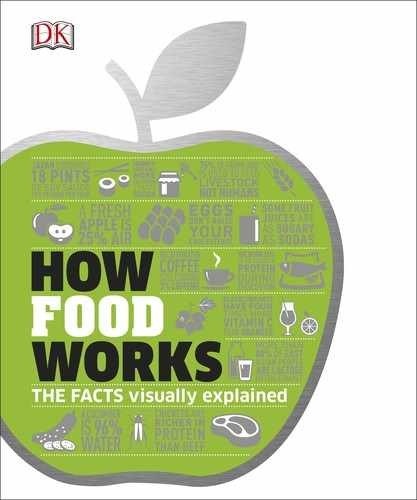
DRINKS
Carbonated drinks
What is in soda?
Typically, a carbonated drink starts as a “simple syrup” of sugar
and water. The other ingredients are then added in a specific order
to give what is called the “finished syrup.” This is diluted with
water, carbonated, and bottled (or canned). For some bottled drinks,
carbonation is done after bottling, just before the bottle is sealed.
Carbonated drinks
Many people enjoy carbonated drinks as a regular
part of their diet. Although they are mostly water,
they contain a significant quantity of sugar and have
been implicated in a number of health problems.
Under pressure
Putting the fizz in a drink is achieved by bubbling carbon dioxide gas through
the liquid under high pressure, so that the carbon dioxide dissolves. When the
pressure is released, the carbon dioxide forms gas bubbles again.
Containing the fizz
The carbon dioxide remains dissolved because
it is kept under pressure. Some of the dissolved
carbon dioxide forms carbonic acid.
Bottle
cap keeps
pressure
on dissolved
carbon
dioxide
in water
When bottle is opened,
carbon dioxide forms
bubbles of gas
Water
(H
2
O)
Additives
The additives in sodas
are mainly colorings and
flavorings, but also acids (citric
and phosphoric acid) to add
“sharpness,” preservatives,
emulsifiers, and antioxidants.
Sugar
A typical soda contains up to
12 percent sugar. In a 11 fl oz
(330 ml) can of regular soda, this
equates to about nine
teaspoons of sugar. In
diet soda, some or
all of the sugar is
replaced with
sweeteners.
ANTIOXIDANTS
PRESERVATIVES
COLORINGS
FLAVORINGS
ACIDS
EMULSIFIERS
KEY
Carbon
dioxide
(CO
2
)
TONGUE
Feeling the fizz
Opening the bottle releases the pressure, allowing
the carbon dioxide to become a gas again.
Carbonic acid in the liquid gives a “sharp” taste.
S
U
G
A
R
7
–
1
2
%
ADDITIVES 3%
Carbon dioxide
bubbles burst
on tongue
US_160-161_Fizzy_Drinks.indd 160 18/01/2017 09:46
160 161
DRINKS
Carbonated drinks
Sodas began as health tonics, based on the
widespread belief that carbonated spa
waters were healthy. Cola drinks began
as a mixture of wine and cocaine until
Prohibition in 1886, when the wine was
replaced by soda water. Cocaine remained
until 1904, when its addictive qualities
became a matter of concern.
TRUCKS TRANSPORTING
SODA HAVE TO DISPLAY THE
HAZARD WARNING SYMBOL
FOR HIGHLY CORROSIVE MATERIAL
Supersizing drinks
The introduction of cheap sugar alternatives in the 1970s led to an
increasing supersizing of soft drinks. Previously, drinks came in
6.5 fl oz (190mL) bottles, but the standard can now contains 110 fl oz
(330mL). As a result, people are often consuming significantly
more calories in drinks than they could possibly eat.
Tooth staining and decay
The sugar in soda contributes
to the buildup of plaque, which
can lead to staining and decay.
Rotting the teeth
It is not only the sugar in sodas
that is bad for you; they also
contain three acids—citric,
carbonic, and phosphoric. These
all have an average pH of 2.5,
which is slightly stronger than
stomach acid. These acids erode
the enamel of teeth, exposing
them to microbial attack and
subsequent decay.
Water
Water makes up most of a
soft drink. Usually taken from
the city water supply, the
water is filtered and
treated to remove solid
particles and microbes
before adding sugar
and additives. After
this, the liquid is
carbonated.
TOXIC TONICS
2 BAKED POTATOES
5oz (200g)
LARGE SIZE
CARBONATED
DRINK
32fl oz (940mL)
Movie theater-sized
portion is equivalent to
three standard cans
Butter not
included in
calories
W
A
T
E
R
8
5
%
364 CALORIES 376 CALORIES
US_160-161_Fizzy_Drinks.indd 161 23/02/2017 11:27

160 161
DRINKS
Carbonated drinks
Sodas began as health tonics, based on the
widespread belief that carbonated spa
waters were healthy. Cola drinks began
as a mixture of wine and cocaine until
Prohibition in 1886, when the wine was
replaced by soda water. Cocaine remained
until 1904, when its addictive qualities
became a matter of concern.
TRUCKS TRANSPORTING
SODA
HAVE TO DISPLAY
THE
HAZARD WARNING SYMBOL
FOR HIGHLY CORROSIVE MATERIAL
Supersizing drinks
The introduction of cheap sugar alternatives in the 1970s led to an
increasing supersizing of soft drinks. Previously, drinks came in
6.5
fl oz (190mL) bottles, but the standard can now contains 110
fl oz
(330mL). As a result, people are often consuming significantly
more calories in drinks than they could possibly eat.
Tooth staining and decay
The sugar in soda contributes
to the buildup of plaque, which
can lead to staining and decay.
Rotting the teeth
It is not only the sugar in sodas
that is bad for you; they also
contain three acids—citric,
carbonic, and phosphoric. These
all have an average pH of 2.5,
which is slightly stronger than
stomach acid. These acids erode
the enamel of teeth, exposing
them to microbial attack and
subsequent decay.
Water
Water makes up most of a
soft drink. Usually taken from
the city water supply, the
water is filtered and
treated to remove solid
particles and microbes
before adding sugar
and additives. After
this, the liquid is
carbonated.
TOXIC TONICS
2 BAKED POTATOES
5oz (200g)
LARGE SIZE
CARBONATED
DRINK
32fl oz (940mL)
Movie theater-sized
portion is equivalent to
three standard cans
Butter not
included in
calories
W
A
T
E
R
8
5
%
364 CALORIES 376 CALORIES
US_160-161_Fizzy_Drinks.indd 161 23/02/2017 11:27
..................Content has been hidden....................
You can't read the all page of ebook, please click here login for view all page.
